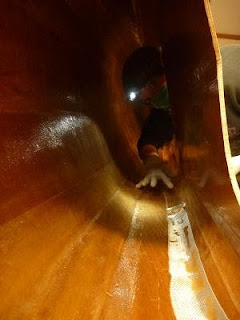Cutting hatches...definitely one of the scariest steps in the process. We are going to take our beautifully put together and fiberglassed boats and just cut holes in them??? Talk about nerve-racking (I looked it up, wracking and racking are interchangeable). Just an fyi, we are doing this step a bit out of order so that we can use the hatch openings to extend the fiberglass tape that goes on the inside of the shear seam, as well as just make the step after easier (you'll see).
To start with you take the wood spacers provided with the hatch kit and measure and draw out the outline of where you will cut. Be sure to measure according to the instructions and measure from the inside of the spacer. I messed this up originally and ended up cutting my spacer way too much at first (I just joined the cut off pieces back on with fiberglass tape, just like connecting the butt ends of the panels). After that experience I opted to wait until after I cut the hatches out to cut the spacers, I think that worked better.

Once everything is finally measured correctly you take a drill and drill five holes right next to each other along the hatch line (Kelly didn't do this step and it seemed to work out just fine). Then you take a thin fine tooth (the finer the better I think) jigsaw blade, clamp it in a vise grip, and saw away! It wasn't perfect, the lines were a bit wiggly but since what you cut out will be the hatch cover it doesn't matter too much, the wigglies will match up.

Saw, saw, saw. It took awhile, we wanted to be careful.

Then when it is just about cut all the way I punched it out from inside! Blam!
Just kidding. That would be reckless (reckless, not wreckless although it would potentially also be without any wrecks).

Now there are hatches!
 Stern bulkhead.
Stern bulkhead.
 This is Kelly being pissed off at the stern bulkhead.
This is Kelly being pissed off at the stern bulkhead.



















